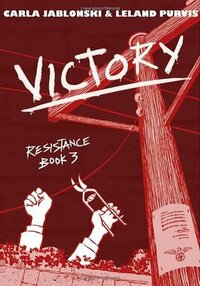Take a photo of a barcode or cover
This is the final book in the Resistance trilogy and the stakes are higher than ever. The Tessier family are all in the resistance and doing their part in some way. Sylvie is dating a German soldier in order to gain information. Marie has found an injured pilot and they are hiding him from the Germans and the collaborators in their town. Paul travels to Paris on a dangerous mission and is reunited with Henri. This book really shows how fragmented the resistance movements were and how some of them did not agree with giving Charles de Gaulle power over them or credit for their successes. However, the Americans are in the war and the tide is changing. The Germans are on the run, but are still determined to create as much death and destruction as possible before leaving. This has been a really good series showing the French resistance during WWII, not a subject that is often covered in literature for this age group.
Resistance is an excellent trio of graphic novels about one French family during World War II, living in the "free" part of France during German occupation. There is the artist son who is in his early teens, the social daughter in her late teens, and the isolated prepubescent daughter, along with their mom and aunt. Their absent POW dad impacts their dynamics.
Over the course of the three books, Resistance, Defiance, and Victory, each member of the family goes from mildly resentful to fully and dangerously involved in the resistance movement. None intends to get involved at the start and each takes his or her own path getting there, for many different, complicated reasons. Life is uncertain in an occupied state, for loyalties, motives, and honesty are always in doubt, even among friends, neighbors, and families. Everyone has secrets, trust is always a risk, and someone hostile is always near. This is not an easy or simple story, but it is a moving and realistic one.
My only real complaint was with the illustrations--I often had trouble determining facial expressions and body language, which should be some of the most important information communicated by the pictures in a graphic novel. This often left me awkwardly feeling as though I were missing part of the story, and I had to piece things together from the dialogue and context as much as I was able.
Over the course of the three books, Resistance, Defiance, and Victory, each member of the family goes from mildly resentful to fully and dangerously involved in the resistance movement. None intends to get involved at the start and each takes his or her own path getting there, for many different, complicated reasons. Life is uncertain in an occupied state, for loyalties, motives, and honesty are always in doubt, even among friends, neighbors, and families. Everyone has secrets, trust is always a risk, and someone hostile is always near. This is not an easy or simple story, but it is a moving and realistic one.
My only real complaint was with the illustrations--I often had trouble determining facial expressions and body language, which should be some of the most important information communicated by the pictures in a graphic novel. This often left me awkwardly feeling as though I were missing part of the story, and I had to piece things together from the dialogue and context as much as I was able.
I'm reviewing all three volumes - Book 1: Resistance, Book 2: Defiance, and Book 3: Victory - together because that's how I read them. They tell one story from beginning to end. I especially loved how the graphic novels captured the complexity of living under occupation as well as the complexity of the resistance movement. People on the same side disagreed and didn't get along and resented each other. It wasn't just "good guys" and "bad guys," and it wasn't always easy to see who was who. Each person had incredibly difficult decisions to make in order to survive and live by her/his own conscience. The novels also really captured the overall sense of fear and mistrust of living under occupation, never knowing who you could trust. I really enjoyed all three graphic novels immensely.
The final installment in Jablonski's Resistance trilogy was just right. It concluded all of the characters' story lines, kept the action going through the end, and completed the plot arc that the first book started. I liked this one as well as the first- it taught me about the French Resistance's part in defeating the Nazis and does so in an interesting way with great characters and story.
This series makes me sad. It DOES get better as it goes along - as you get to know the characters. But it does not achieve what it wants to be. It feels contrived and not like the high adventure historical fiction it could be. Here's a piece of a review I wrote for another source:
Although the topic is fascinating and unique for this audience, there is a contrived feeling to this series. It feels just a little too dogmatic. The reader never truly connects with the characters, and the illustrations, though in beautiful full-color, feel amateurish and uneven. Purvis excels at drawing places and does not excel at drawing people. Unfortunately, there are a lot of human figures in this story. Although this topic is important and worth covering in an adventure-style historical fiction graphic novel like this, hopefully many other cartoonists will follow and be more successful at using this format to its greatest extent.
Although the topic is fascinating and unique for this audience, there is a contrived feeling to this series. It feels just a little too dogmatic. The reader never truly connects with the characters, and the illustrations, though in beautiful full-color, feel amateurish and uneven. Purvis excels at drawing places and does not excel at drawing people. Unfortunately, there are a lot of human figures in this story. Although this topic is important and worth covering in an adventure-style historical fiction graphic novel like this, hopefully many other cartoonists will follow and be more successful at using this format to its greatest extent.
Fast paced. Peril and violence, death and destruction. Secrets and betrayals and lies. And at the end everyone claims to be the good guy. This would have been better with more time and depth. But it worked quite well even almost like a sketch. And in the end I cared about everyone. And in the end I no longer was sure what was truth and what was fiction.
This quote comes from the 2nd installment but is a theme in this final one:
"The Germans are going to win this war. And when they do, which side do you want to have been on?"
In this third book of the trilogy, this statement already looks incorrect, as it does to all of us with the benefit of hindsight. The great thing about these books is, in lines like this, you feel that sense of uncertainty that people, young and old, had, about the future in a way that is usually incomprehensible to me as a safe, 21st century American. These kinds of questions are the important ones for students to be asked to consider when they learn about history, though, and this volume does a good job of showing how "people like a winner" but that there are times (extended periods!) where the winner is not clear, and you have to rely on your principles to tell you who to align yourself with.
"The Germans are going to win this war. And when they do, which side do you want to have been on?"
In this third book of the trilogy, this statement already looks incorrect, as it does to all of us with the benefit of hindsight. The great thing about these books is, in lines like this, you feel that sense of uncertainty that people, young and old, had, about the future in a way that is usually incomprehensible to me as a safe, 21st century American. These kinds of questions are the important ones for students to be asked to consider when they learn about history, though, and this volume does a good job of showing how "people like a winner" but that there are times (extended periods!) where the winner is not clear, and you have to rely on your principles to tell you who to align yourself with.
I enjoyed this series a lot, and learned much about the Nazi occupation of France. This volume wrapped up the story tidily, which was nice for fiction, but I'm sure the happy ending were actually very few and far between.
With Victory, Book 3, the talented team of Carla Jablonski and Leland Purvis will bring their graphic novel trilogy about kids working in the French Resistance during World War II to its conclusion when it is published on July 17, 2012.
Victory begins after the Nazi occupation of France and one month after the allied invasion of Normandy. For the first time, victory seems to be a possibility for the allied forces, but tensions are also running very high. As Nazi losses increase, so does their cruel treatment of their victims. And now, to make matters worse, there is infighting among the different resistance groups.
Paul Tessier has just gotten himself arrested by the Milice (a paramilitary group of Frenchmen formed by the Germans to do their dirty work) to find out what cell another resistance worker is being held in. When he is freed, Paul hurriedly reports back to his friend and fellow resistance worker Jacques with the information.
Meanwhile, Paul's older sister Sylvie is still dating a German soldier in order to get information from him about Gestapo plans. When the soldier tells her that the Gestapo is going to search in the Jura Mountains for the Marquis, a group of resistance fighters, she immediately reports back to Jacques and Paul. Trouble is, however, it looks like Sylvie is beginning to fall for the German soldier, which could be a real problem.
Paul and Jacques now want the resistance workers to arm themselves with stolen German weapons. Since they only have a few weapons, they decide to sabotage a trains using what they have and manage to get more of from the Germans on the train. In retaliation and believing the citizens of this small southern French town know who attacked the train, the Nazis begin to execute 10 townspeople every hour until someone turns the saboteurs in.
While all this is going on, Marie, Paul's younger sister, has been deeply depressed about their father, who is missing in a German POW camp, and their Jewish friend and former neighbor Henri, whom Paul and Jacques helped to escape to Paris earlier, where he was reunited with his parents that everyone had believed to be dead. While out walking in the woods, Marie finds a downed allied airplane with a wounded pilot. She gets Paul to help her hide the pilot so his wounds can be taken care of. The pilot was on a mission to deliver a message to resistance fighters in Paris from DeGaulle in London about the direction he wants the resistance to go in now that the Germans are losing the war. Naturally, Paul and Jacques volunteer to complete the pilot's message, arriving in Paris just in time participate in the Battle of Paris that ultimately leads to its liberation from its German occupiers and the return of Charles DeGaulle. But not before a few surprises for Paul.
Victory is every bit as exciting, informative and well done as the previous two volumes, and every bit a well written as Resistance and Defiance. This story, like it predecessors, is full of intrigue, adventure, danger, and suspense. Altogether these excellently done graphic novels give an interesting perspective on a part of World War II most people don't really know about and would probably not like to think about their kids participating in - young peoples involvement in resistance movements throughout Europe. But it makes you realize how incredibly brave these young people were in the face of such odds.
Leland Purvis has also continued to produce exceptionally well detailed drawings perfectly matched to the text and Hilary Sycamore's coloring only adds to the over effect of the graphics.
All in all, the Resistance trilogy is well worth reading and should be appeal to the most reluctant readers.
Victory begins after the Nazi occupation of France and one month after the allied invasion of Normandy. For the first time, victory seems to be a possibility for the allied forces, but tensions are also running very high. As Nazi losses increase, so does their cruel treatment of their victims. And now, to make matters worse, there is infighting among the different resistance groups.
Paul Tessier has just gotten himself arrested by the Milice (a paramilitary group of Frenchmen formed by the Germans to do their dirty work) to find out what cell another resistance worker is being held in. When he is freed, Paul hurriedly reports back to his friend and fellow resistance worker Jacques with the information.
Meanwhile, Paul's older sister Sylvie is still dating a German soldier in order to get information from him about Gestapo plans. When the soldier tells her that the Gestapo is going to search in the Jura Mountains for the Marquis, a group of resistance fighters, she immediately reports back to Jacques and Paul. Trouble is, however, it looks like Sylvie is beginning to fall for the German soldier, which could be a real problem.
Paul and Jacques now want the resistance workers to arm themselves with stolen German weapons. Since they only have a few weapons, they decide to sabotage a trains using what they have and manage to get more of from the Germans on the train. In retaliation and believing the citizens of this small southern French town know who attacked the train, the Nazis begin to execute 10 townspeople every hour until someone turns the saboteurs in.
While all this is going on, Marie, Paul's younger sister, has been deeply depressed about their father, who is missing in a German POW camp, and their Jewish friend and former neighbor Henri, whom Paul and Jacques helped to escape to Paris earlier, where he was reunited with his parents that everyone had believed to be dead. While out walking in the woods, Marie finds a downed allied airplane with a wounded pilot. She gets Paul to help her hide the pilot so his wounds can be taken care of. The pilot was on a mission to deliver a message to resistance fighters in Paris from DeGaulle in London about the direction he wants the resistance to go in now that the Germans are losing the war. Naturally, Paul and Jacques volunteer to complete the pilot's message, arriving in Paris just in time participate in the Battle of Paris that ultimately leads to its liberation from its German occupiers and the return of Charles DeGaulle. But not before a few surprises for Paul.
Victory is every bit as exciting, informative and well done as the previous two volumes, and every bit a well written as Resistance and Defiance. This story, like it predecessors, is full of intrigue, adventure, danger, and suspense. Altogether these excellently done graphic novels give an interesting perspective on a part of World War II most people don't really know about and would probably not like to think about their kids participating in - young peoples involvement in resistance movements throughout Europe. But it makes you realize how incredibly brave these young people were in the face of such odds.
Leland Purvis has also continued to produce exceptionally well detailed drawings perfectly matched to the text and Hilary Sycamore's coloring only adds to the over effect of the graphics.
All in all, the Resistance trilogy is well worth reading and should be appeal to the most reluctant readers.
Victory completes the Resistance trilogy. The Tessier siblings have each been doing their part for the French resistance, but they are now about to embark on their most dangerous mission yet. This final installment takes us to the streets of occupied Paris where information critical to the success of the Resistance is needed. All three siblings make their way to Paris where they are reunited with their old friend, Henri. The tides of war are turning, but how long will it take for Paris to be truly out from under the German's heels?
Overall, this is a lovely trilogy that highlights the efforts put forth by ordinary people under extraordinary circumstances. There is not a ton of YA fiction out there that details the role of the French during WWII and the graphic novel format makes this era of history that much more accessible. Readers may be surprised to learn that kids their age were indeed playing their own part in fighting the Germans.
Overall, this is a lovely trilogy that highlights the efforts put forth by ordinary people under extraordinary circumstances. There is not a ton of YA fiction out there that details the role of the French during WWII and the graphic novel format makes this era of history that much more accessible. Readers may be surprised to learn that kids their age were indeed playing their own part in fighting the Germans.



